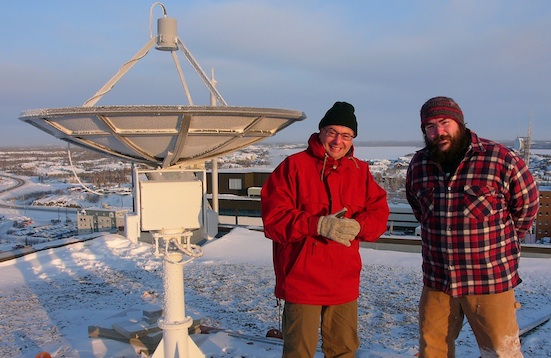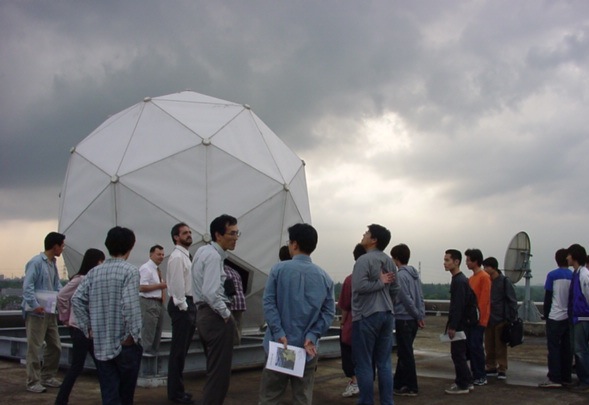Global Imaging offers a range of precision program tracking antennas, ranging in size from 0.8m to 3.0m in diameter.
Choices of LNA/Downcoverters are available covering L, S and X band telemetries. Receivers, bit and frame synchronizers allow interfacing the
antenna to our LINUX-based NEXGEN Front End Processors for generation and distribution of higher-level products.


Polar Tracker
The Ultimate Earth Station for Polar Orbiting Spacecraft Tracking
Global Imaging’s PolarTracker earth station is a fully integrated satellite tracking, acquisition, and processing system for the reception of data from polar orbiting environmental spacecraft including NOAA TIROS, SeaStar ocean color, and military DMSP satellites. Each Polar Tracker earth station includes a powerful Linux-based computer, software for antenna control and automatic operation, data processing software, and a collection of general image processing and display functions. PolarTracker data processing software includes functions for AVHRR processing, TOVS sounder processing, ARGOS processing, SeaStar SeaWiFS, and DMSP OLS and SSM/I processing
Applications
Global Imaging’s PolarTracker earth station is a fully automated system which offers the latest in hardware and software technology for a wide variety of ocean, land, and atmosphere applications.
· Meteorology and Weather Forecasting
· Physical & Biological Oceanography
· Hydrology
· Fisheries
· Wildlife Research
· Agriculture & Forestry
· Naval & Coast Guard Operations
· Volcanology
· Climate and Global Change Studies
· Land-based Change Detection Studies (e.g. urbanization, tropical deforestation, desertification)
· Seamless Integration with Digital Elevation Models
All Weather Operation Downlink
The PolarTracker outdoor assembly includes a tracking antenna, pedestal, D-band feed, fully sealed low noise amplifier (LNA) and synthesized downconverter. The pedestal and positioner are fabricated from low corrosion aluminum alloy which offers exceptional outdoor durability. The rugged exterior components of the downlink have been field tested in the searing heat of North Africa, as well as the deep freeze of Antarctica and Alaska. The operating temperature range of the antenna system is -40° to +85° C. For operation in gale force winds and in conditions of heavy icing, we offer an optional geodesic dome enclosure, permitting all-weather operation.
Horizon-to-Horizon Coverage
The PolarTracker is the only earth station in its class which offers true horizon-to-horizon coverage with no overhead keyhole effect. The highest gain, lowest noise amplifiers in the industry along with aluminum mesh and solid reflector dishes ranging up to 1.73 m in diameter provide true horizon to horizon tracking. The PolarTracker’s full 180° elevation over 360° azimuth tracking capability, along with the most sophisticated tracking software available, provides continuous uninterrupted spacecraft tracking even for direct overhead passes. Competing systems which lack this capability often drop out critical data at the zenith of the pass, creating a “keyhole” of missing data.
Superior Scientific Servers and Workstations
Each PolarTracker earth station includes a powerful LINUX Ingest server. Data is sent directly to the disk of the workstation via a multi-satellite bit/frame sync card which is installed in a SCSI-based telemetry chassis.
Global offers a wide variety of workstation choices – all deliver exceptional floating point/cost performance and include numerous graphics options. Linux based scientific workstations will meet the needs of even the most computationally intensive application.
Automatic Operation
The PolarTacker is a completely automatic earth station. No operators are required. Even orbital element sets are down-loaded automatically. System managers control the automatic operation of the system using the Automatic Satellite Acquisition and Processing (ASAP) windows software. ASAP software allows the system manager to specify how many time periods of data to keep for each satellite, which disk drives will be used for data storage, how the data will be processed, and where the processed data will be sent. ASAP software is invaluable when automated overflight scheduling, data acquisition and processing is required.
PolarTracker Data Processing Software
Each PolarTracker earth station includes a complete set of data processing software with functions for:
AHVRR processing including precision navigation, radiometric calibration, and geophysical algorithms for cloud screened surface albedo, land and ocean temperature, and vegetation indices.
TOVS processing using the International TOVS Processing Package (ITPP) for atmospheric temperature and moisture profiling. TOVS processing is fully integrated with NCAR graphics for easy display of geopotential height contours and geostrophic wind vectors and velocities.
ARGOS processing including earth location, data retrieval, and data reduction to geophysical units.
DMSP OLS processing including precision navigation and radiometric calibration.
DMSP SSM/I processing.
Over 250 general purpose image processing functions including functions for sampling, filtering, mathematics, and interpolating to standard map projections using USGS GCTP II software.
FOCUS 9000 Interactive Image Display
For displaying and interactively manipulating graphics and image data, Global Imaging provides FOCUS software with each earth station. Because FOCUS display commands are grouped together logically in pull-down menus, FOCUS software is extremely easy to learn and to use. FOCUS includes functions for altering image contrast and brightness, for overlaying latitude longitude grids and for automatically drawing coastlines from an on-line worldwide database. FOCUS provides for eight independent graphic overlay planes and pseudocolor and monochrome lookup tables. Operators can also use FOCUS to pan and zoom image data, annotate images, and produce animation loops.
_________________
